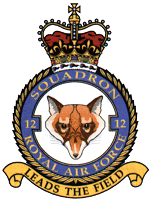


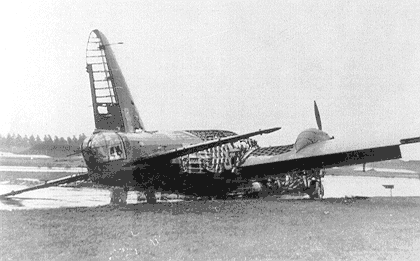
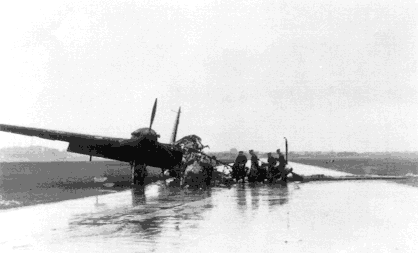
 |
| Sergeant Jack Newton |
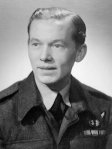 |
| Richard Copley in 1946 |
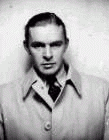 |
| Roy Langlois on the run in 1941 |
 |
| Emille Witmeur |
At about the same time as they left
their aircraft on the airfield at Antwerp another Wellington bomber
crashed in the Meuse. The Germans had recovered three of the crew dead
and used their flying clothes to disguise some Germans as evading
aircrew in order to trap people willing to help evading British airmen.
" I am sure they are British" Witmeur continued. "They were forced to
land in Antwerp, on the airfield at Deurne"
"Where? On the airfield.....you fool, why not on the moon. They have
told you that because you will not be able to enter the airfield to
confirm their story".
Doneux refused to take the airman and so Witmeur, convinced the airmen
are British, decided to take them to his own house, when they arrive
German soldiers are standing in the street. Witmeur, Doneux and the
airmen turn back. Meanwhile Venderweerdt has alerted other Beaver-Baton
agents, Doctor Georges GILLES and Fernand CARLIER, they all had a
meeting in a cafe.
Doneux said, "Even if they are Germans all is not lost, if I can reach
the hotel without being followed. We will radio London and check their
story. If they are Germans we will kill them."
At seven in the evening the airmen and their helpers arrived at the
Hotel de Provence, 127 Rue des Guillemans owned by Eugene DEMEURRE. The
airmen had to tell their story again and during the night  London was contacted. The story checked out, they were not
German. The next day Langlois was taken to the flat of Jean HUFKENS at
the Place St. Paul, Newton to Rene DEBAITS (picture left) house and
Copley to gendarme Armand LOVENFOSSE's house.
London was contacted. The story checked out, they were not
German. The next day Langlois was taken to the flat of Jean HUFKENS at
the Place St. Paul, Newton to Rene DEBAITS (picture left) house and
Copley to gendarme Armand LOVENFOSSE's house.
The plan was to fly the three airman back to England
from an airfield in France. This plan and a letter to Monsieur Pierlot
( the Belgian prime-minister in exile in London) asking for the release
of certain money, were baked in a cake for Langlois to take to England.
They remained in these houses until the 8th September 1941 when it was
arranged by Nicholas MONAMI the Mayor of Bassence and head of
Beaver-Baton and Police Commisioner Louis RADEMECKER to take them to
the escape organisation in Brussels. The airmen met up again in the
square in front of the Post Office in Liege and were taken by two men
on the train to Brussels, arriving at 20.00 hours.
SEPTEMBER 1941
The airman arrived in Brussels at a dangerous time, from the beginning
of September 1941 the Germans had began to crack down on the
organisation. There was talk that a red headed English or Irish soldier
who had been captured earlier had, under German threats, infiltrated
the organisation to betray it. Langlois and Copley were taken to a
different house from Jack Newton and from then on his experiences would
radically differ from the other two.
Langlois and Copley's first three days in Brussels were spent in the
old and beautiful house of a wealthy Lieutenant in the Belgian Army and
his sister, he was an Olympic standard swordsman.
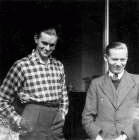
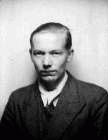
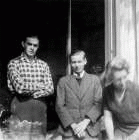
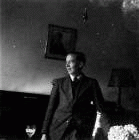

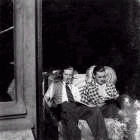
Langlois and Copley were looked after in Brussels by Baron Jacques
DONNY aka Pere NOEL (Father Christmas) he was unable to accommodate
them in his own house but took them to stay the night of the 12th
September with an unknown woman. Possibly this is when they stayed at
Jeanne Monnier's house. The next day Baron DONNY took them to the home
of Jean VANDENHOVE above his tobacconists shop at 66 Rue Washington.
Whilst there they also visited other homes, the names of the
householders unknown or forgotten with the passage of time. One was the
upper story apartment of a doctor and his wife, they also visited a
vineyard by train, the owner was short, slight of stature and had a
small dark moustache, a double of Charlie Chaplin. Another visit to the
countryside just outside Brussels was to a smallholding where the owner
was a body builder. They were also given identity cards and visited by
an Englishwoman who was to give them French passports and Spanish
visas. They were to travel with three ex-Belgian army officers as
guides to Montpelier, and then make contact with a Spanish guide.
Langlois had also been given various pieces of military information to
take back to England.

John Ives RCAF
So the network had sent some soldiers on to Spain but all the time
others were arriving. Michel KOWALSKI and Stephan TOMICKI 305 Squadron
Wellington crashed near Charleroi on the same night as G for George.
They had been on a mission to Frankfurt. Taken to Brussels they met up
with Allan Cowan and the other Scottish soldiers.
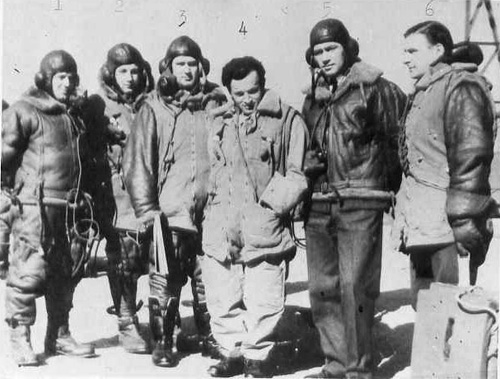
John IVES RCAF R-62735 51 Squadron who had been an Observer on a raid
to Cologne on the night of 18/19th August 1941. After taking off from
RAF Dishforth at 21.51 their Whitley V bomber Z6569 MH-S was shot down
by a night fighter over Vliermaalroot, Limburg 9km SE of Hasselt. Ives
evaded capture and stayed at a farm in Diepenbeek near Hasselt. He
arrived in Brussels on the 28th August 1941.
By now The Geheime Feldpolizei was closing in on the group, the first
arrests had been made, disaster was about to strike.
RAF Airmen Hidden in Brussels in 1941.
F/Lt Jan Ryszard JANICKI P1405 300 Sq RAF Born 8/7/1912. Arrested Gare Du Midi Brussels 26/9/41 POW. Janicki returned to Poland in 1946.
11th July 1941
300 Squadron Wellington IC R1184 BH-B T/O Swinderby on operation to Cologne. Shot down, landed by parachute near Turnhout.
All the crew POW's
Flight Lieutenant 37938 Roy Brouard LANGLOIS D.F.C. 12 Sq RAF FTR 5/8/41. Arrested 1/10/41 rue Washington, Brussels POW.
Took part in "The Great Escape" Stalag Luft III Sagan. Died 1993.
Flight Sergeant 748217 Richard Alfred COPLEY radio operator 12 Sq RAF FTR 5/8/41.
Arrested 1/10/41 rue Washington, Brussels
POW
Sergeant Jack L. NEWTON 742570 front gunner 12 Sq RAF FTR 5/8/41. Comete Line Evader. Died 2003.
Sergeant John Warren McLARNON 964321 second pilot 12 Sq RAF FTR 5/8/41. Arrested Toulouse POW
Sergeant Harold Joseph Edwin BURRELL navigator 12 Sq RAF FTR 5/8/41. Arrested Toulouse POW
Sergeant R.D. PORTEOUS RNZAF rear gunner 12 Sq RAF FTR 5/8/41. Arrested Toulouse POW
5th August 1941
12 Squadron Wellington I W5421 PH-G T/O Binbrook on operation to Aachen, Forced landing Antwerp/Duerne airfield.
Squadron Leader Szczepan SCIBIOR 305Sq. RAF FTR 5/8/41. Arrested August 1941 Brussels POW. Executed Warsaw 7/8/1952
as British spy.
Sgt. Stefan TOMICKI 782361 305Sq. RAF FTR 5/8/41 Comete Line Evader.
After his return to the UK his Wellington Bomber HE 148 crashed on 9.4.1943 in the North Sea near the Dutch coast.
His body was never found.
Sgt. Michal Ryszard KOWALSKI 782276 305 Sq. RAF FTR 5/8/41 Comete Line Evader.
He lived in Canada after the war and died in Montreal in 1996.
5th August 1941
305 Squadron Wellington II W5593 SM- Took off Lindholme on operation to Frankfurt.
Crashed near Charleroi , three crew killed.
Charleroi Polish Memorial
Sergeant Albert D. DAY 10263 RAF 77Sq. RAF Comete Line Evader. Al died in 2007.
F/Lt Douglas Gordon BABER 89376 77 Sq. RAF Arrested in Brussels 27th August 1941.
W/O William Frederick THUELL 89376 77 Sq. RAF Hidden at Zingen but arrested in Brussels 27th August 1941. Died 1990.
5th August 1941
Whitley V Z6826 KN- on operation to Frankfurt T/O Topcliffe diverted to bomb Koblenz hit by flak crashed near Meulbeke, West Flanders.
Rest of crew POW's.
Sgt John Learned IVES RCAF R-62735 51 Sq. RAF Comete Line Evader. Killed plane crash 28th April 1945
18th August 1941
51 Squadron RAF Whitley V Z6569 MH-A T/O Dishforth 21.29 on operation to Cologne.
Shot down by night-fighter, crashed Vliermaalroot Limburg. Rest of Crew 1 Killed 3 POW.
Sgt Leonard Arthur WARBURTON 992847 Comete Line Evader
Sgt John William (Jack) HUTTON 1678696 Comete Line Evader. Killed 31/07/1944 Buried Clichy Northern Cemetary.
31st August 1941
101 Squadron Wellington Ic R1703 SR-J T/O Oakington for operation on Cologne.
Crashed at Boxbergheide near Ghent, Three crew killed buried at Schaffen Communal Cemetary, one (R.T. Wood) POW.
See Frank Haslam's website on the Boxbergheide Memorial
Sergeant Hilary (Larry) Eldred BIRK 402634 RAAF 99 Sq. RAF. Comete Line Evader.
Killed plane crash 15th July 1942. Buried Benghazi War Cemetary.
Sergeant W.H.DYER Evader reached Spain February 1942
28th September 1941
99 Squadron Wellington IC X9761 LN- T/O Waterbeach on operation to Frankfurt.
Sergeant J.B. DICKS Evaded to Spain but did not go to Brussels.
Pilot Officer Howard CARROLL 68806 207SQ. RAF. Comete Line Evader. Killed plane crash 19th November 1945.
Buried at Hanover War Cemetary.
Sgt Gilbert Thomas (Tom) COX 1251523 Comete Line Evader
14th October 1941
207 Squadron Manchester I L7321 EM-D on operation to Cologne.
Shot down by night-fighter crashed Hozemont Belgium. Five crew killed buried at Heverlee War Cemetary.
Information from
"Royal Air Force BOMBER COMMAND LOSSES of the Second World War 1941 by W.R. Chorley" Published by Midland Counties Publications.
The Commonwealth War Graves website.
Click on www.belgiumww2.info to go to INTRODUCTION
© John Clinch 2002